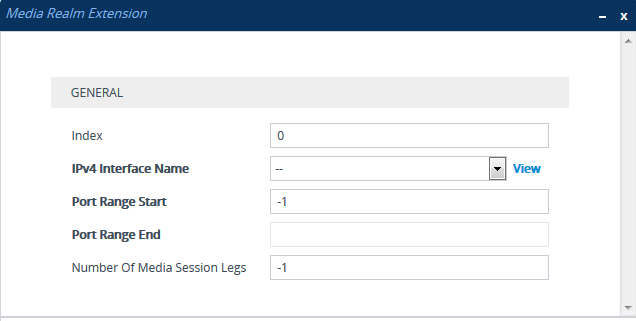Configuring Media Realm Extensions
The Media Realm Extension table lets you configure up to
Media Realm Extensions can be useful, for example, to overcome limitations of the maximum number of media ports supported per interface. Instead of configuring only a single Media Realm in the Media Realms table (see Configuring Media Realms), you can also configure additional "Media Realms" in the Media Realm Extensions table associated with the single Media Realm. An IP Group that is associated with a Media Realm configured with Media Realm Extensions, allocates its media sessions / ports between the different interfaces, as configured by the Media Real and its associated Media Realm Extensions. For example, two Media Realm Extensions could be configured, whereby one allocates 25 media sessions on interface "LAN-1" and another, 10 sessions on interface "LAN-2". The Media Realm associated with these Media Realm Extensions would be assigned to the relevant IP Group.

The following procedure describes how to configure Media Realm Extensions through the Web interface. You can also configure it through ini file [MediaRealmExtension] or CLI (configure voip > voip-network realm-extension).
| ➢ | To configure a Media Realm Extension: |
| 1. | Open the Media Realms table (see Configuring Media Realms). |
| 2. | Select the Media Realm for which you want to add Remote Media Extensions, and then click the Media Realm Extension link located below the table; the Media Realm Extension table appears. |
| 3. | Click New; the following dialog box appears: |

| 4. | Configure the Media Realm Extension according to the parameters described in the table below. |
| 5. | Click Apply. |
Media Realm Extension Table Parameter Descriptions
|
Parameter |
Description |
|||||||||
|---|---|---|---|---|---|---|---|---|---|---|
|
'Index' [MediaRealmExtension_ExtensionIndex] |
Defines an index number for the new table row. Note: Each row must be configured with a unique index. |
|||||||||
|
'IPv4 Interface Name' [MediaRealmExtension_IPv4IF] |
Assigns an IPv4 network interface By default, no value is defined. To configure IP network interfaces, see Configuring IP Network Interfaces. Note:
|
|||||||||
|
'IPv6 Interface Name' [MediaRealmExtension_IPv6IF] |
Assigns an IPv6 network interface By default, no value is defined. Note:
|
|||||||||
|
'Port Range Start' [MediaRealmExtension_PortRangeStart] |
Defines the first (lower) port in the range of media UDP ports for the Media Realm Extension. By default, no value is defined. Notes:
|
|||||||||
|
'Port Range End' [MediaRealmExtension_PortRangeEnd] |
Defines the last (upper) port in the range of media UDP ports for the Media Realm Extension. Note: It is unnecessary to configure the parameter. The device automatically populates the parameter with a value, calculated by the summation of the 'Number of Media Session Legs' parameter (multiplied by the port chunk size) and the 'Port Range Start' parameter. After you have added the Media Realm Extension row to the table, the parameter is displayed with the calculated value. |
|||||||||
|
'Number Of Media Session Legs' [MediaRealmExtension_MediaSessionLeg] |
Defines the number of media sessions for the port range. For example, 100 ports correspond to 10 media sessions, since ports are allocated in chunks of 10. By default, no value is defined. Note: The parameter is mandatory. |